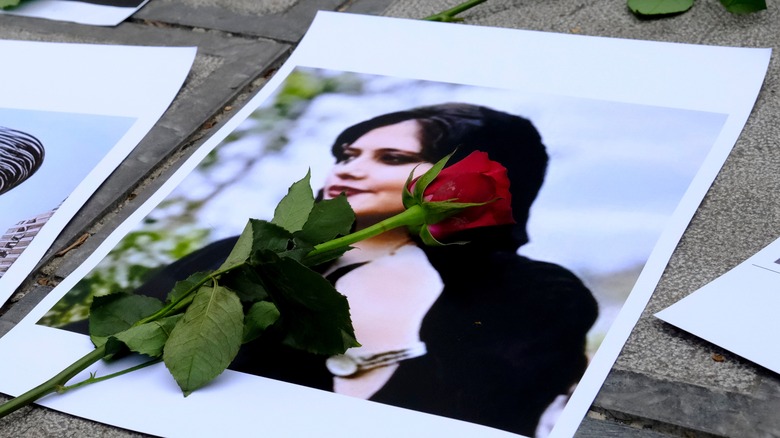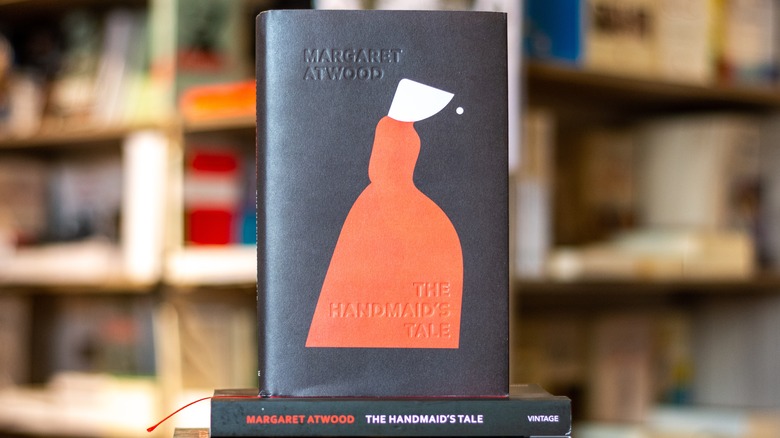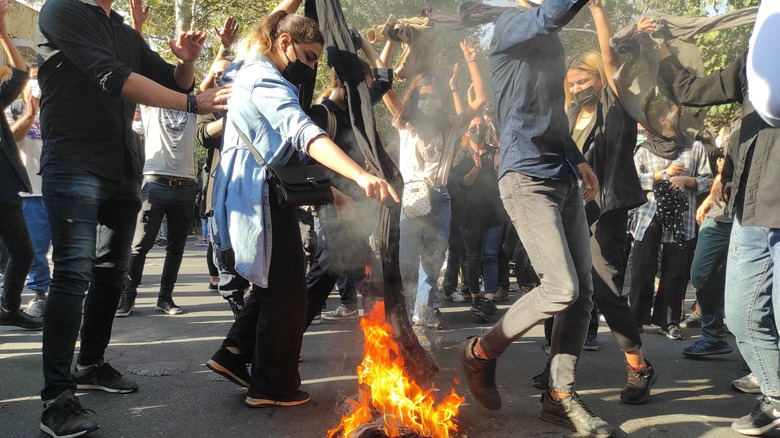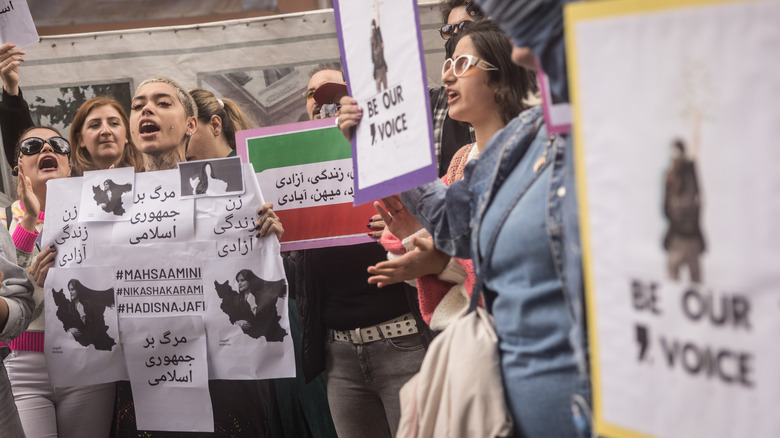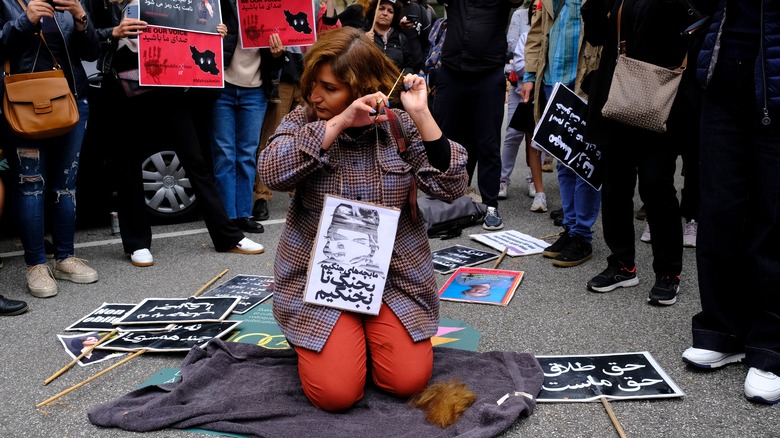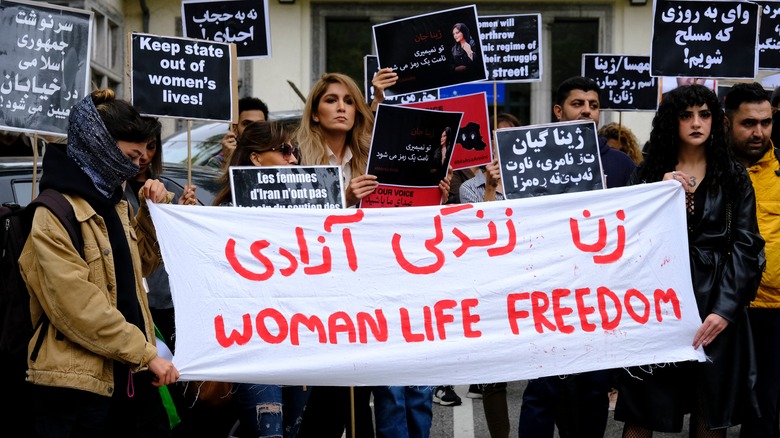What The Handmaid's Tale Can Teach Us About The Women-Led Protests In Iran
We may receive a commission on purchases made from links.
Margaret Atwood hasn't been shy about "The Handmaid's Tale" being based on real-world events. The Harvard graduate based the book in and around Cambridge, which the Hulu adaptation has kept true to. But the protest scene in Season 1, Episode 3 of Hulu's adaptation of the book looks more like a scene out of present-day Tehran than Boston.
Younger generations of Americans might just be waking up to the continued struggles for gender equality as the broader effects of the Supreme Court overturning Roe v. Wade come to light. But Iranians have been fighting to get equal rights back since March 1979, when — as The Washington Post reported — women took to the streets, protesting a rumor about compulsory hijab wearing that would later become a reality. The protest, held on International Women's Day, brought more than 100,000 women to the streets who saw the rights they used to have under the shah be stripped away by Ayatollah Khomeini in the newly-established Islamic Republic of Iran (via Rare Historical Photos).
But the protests that have been breaking out nationwide daily in Iran since the death of Mahsa Amini on September 16 have more fire and fury than Iranians have seen in generations.
Rama Rahimpour explained to Jon Stewart on an episode of his podcast, "The Problem With," that these younger generations of protestors not only have more anger but have a clear goal: bring an end to the gender apartheid in Iran at any cost.
The similarities between present-day Iran and Gilead
In Hulu's adaptation of "The Handmaid's Tale," scenes from the show's present are juxtaposed with slices of the past, showing how things changed for women slowly, and then all at once. In Season 1, Episode 3, June and Moira attend a protest after a law goes into effect banning women from holding jobs and bank accounts.
In a Reddit AMA, Margaret Atwood assured fans that nothing that happened in "The Handmaid's Tale" didn't already happen somewhere in the world. Iran, like Atwood's Gilead, had seen a vicious rolling back of equal rights for women. During a panel about "What Iranian Women Want the World to Know About their History" at the Georgetown Institute for Women, Peace, and Security, Dr. Nina Ansary brought up the influence of Zoroastrianism — the area's dominant religion prior to the rise of Islam — had put women's rights beyond even what many countries have today.
In an op-ed for The New York Times, Azadeh Moaveni explained that in the time leading up to the 1979 Islamic revolution, the black chador became the symbol of the movement, that the right to practice their religion publicly. Rama Rahimpour adds when talking to Jon Stewart, however, that religious radicals hijacked the revolution, not unlike, as she points out, what happens in "The Handmaid's Tale."
But the post-Iranian revolution protests back in 1979 began for the same reason they started a few weeks ago: women want control of their bodies back.
How the death of 22-year-old Mahsa Amini sparked new protests in Iran
When Mahsa Amini was arrested on September 13 by Iran's "morality police," it wasn't because she was ignoring the country's mandatory head covering law. As Rama Rahimpour explained to Jon Stewart, Amini wasn't following the law enough.
On August 14, 2022, Iranian President Ebrahim Raisi signed a new order adding new restrictions to how women are able to dress inside Iran. The consequences of breaking these laws, Radio Free Europe reported, can mean you're "deprived of some social rights for six months to one year" — but only for something as "small" as an Iranian woman posting a picture of herself bareheaded on social media. According to ABC Australia, "anyone who explicitly violates any religious taboo in public" in Iran "should be imprisoned up to two months, or flogged with 74 lashes" which most often turns into women being taken to "guidance centers" to be "retrained" on how to "dress appropriately" in accordance with Iranian law.
Around the time the new dress code went into effect, The Guardian published a piece about when Sepideh Rashno went on national television to apologize for the footage that went viral of her being harassed on a bus being "dressed inappropriately." Hrana, a human rights group, told The Guardian that Rashno had been beaten and tortured before she was forced to apologize.
For having some hair showing while walking through Iran's capital of Tehran, Amini paid with her life.
The 2022 protests in Iran are different than what the country has seen before
The message of this new wave of women's rights protests in Iran is different from what the country has seen in the past. Beyond wanting a complete regime change, how people — not just women — are protesting and where they're showing up to send their message is something Iran hasn't been exposed to in previous protests.
Pushback from the country's security forces is nothing new for veterans of Iranian protests. Protests in 2019 saw a complete shutdown of the internet and 304 deaths minimum, per Human Rights Watch. However, this most recent crackdown on restricting women's rights could change things.
The teenagers and young women at the front of these protests in Iran don't want things to go back to the way they used to be because the Iran of today is the only Iran they know. The Iran they know murdered a 22-year-old woman because her headscarf wasn't on properly (via The Cut). The Iran they know murdered a 17-year-old girl — Nika Shakarami — and refused to let her family bury her, fearing the funeral would set off more protests, per The Washington Post.
Anti-hijab protests have taken place in the past, but in the weeks since Amini's death while in custody of the morality police, women and teenagers have been burning their headscarves and dancing in the streets in direct defiance of the law that killed Amini.
Iranian people of all generations are fighting back
Fear of consequences — torture, death — used to keep the Iranian people in line. But as the death toll from security force response to the protests continues to climb, Iranian fear only seems to shrink. Now, the streets aren't the only place of protest inside Iran. CNN shared reports of videos of girls in classrooms, singing protest songs as they wave their headscarves in the air. This is in the face of reports The Guardian shared about Iran using facial-recognition technology to track women and girls who break the hijab rule.
But the younger generations aren't the only ones standing up to the Iranian government. According to Time, older generations of both men and women are backing the protestors as best they can. "After decades of financial, social, and political confinement," Time explained, they "feel they have nothing left to lose." Rama Rahimpour told Jon Stewart that her own mother, who currently lives in Tehran, wanted to go out and join the protests. "You know what," Rahimpour's mother told her, "if they're going to kill someone, I want them to kill us because we've lived our lives."
Rahimpour also spoke of the bravery of the older generations who, if they're able, are out on the streets with these young women and girls, chanting "death to the dictator" with their headscarves in their hands.
Change is coming for Gilead and Iran
If you've read Margaret Atwood's "The Handmaid's Tale," you know Gilead eventually falls. Their way of life is unsustainable, especially when even those enforcing the laws not only don't believe in them but begin working against the government they helped create. As the fictional fall of Gilead begins to play out in Season 5 of "The Handmaid's Tale," it's hard not to wonder — and hope — the same thing is happening in Iran.
In Season 5, Episode 5 of "The Handmaid's Tale," June and Luke meet someone from the generation below them, someone who grew up in Gilead but who still questions why things need to be this way. He couldn't remember a time before Gilead; he just knew the way they were living now wasn't right.
But just like with the young Guardian, there are still limits to how much help those within the system are providing those wanting to overturn it. On October 5, Human Rights Watch reported "numerous incidents of security forces using excessive or lethal force against protesters in 13 cities across Iran." According to Reuters, security forces open-fired on protesters in at least two cities, bringing the reported death toll of these protests up to over 150.
"We are no longer afraid," EuroNews reported one protest banner saying, adding that it promised: "We will fight." This is what the Iranian people are doing: fighting, and pushing for a future where "better" means better for everyone, not just wealthy men.
